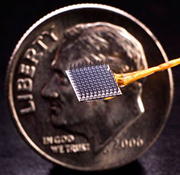

(c) Matthew McKee/BrainGate Collaboration
埋め込み式のBrainGate神経インターフェース
手足が麻痺した患者が,脳からの信号だけでコンピュータのカーソルや補助器具を動かすことができる装置について,予備的な臨床研究が行われている。BrainGateと名づけられたこの豆粒大の装置は,大脳皮質に埋め込まれ,運動を制御する脳の電気シグナルを感知する。このシグナルがコンピュータを介してカーソルや補助器具の動きにつながる。今回の研究は,脊髄損傷,脳幹卒中,筋ジストロフィなどで四肢全ての力が弱い患者を対象としている。この装置は,高度な義肢を動かす装置としても研究されているという。(吉田素子)
Stanford Joins BrainGate Team Developing Brain-Computer Interface to Aid People with Paralysis
Stanford University researchers are enrolling participants in a pioneering study investigating the feasibility of people with paralysis using a technology that interfaces directly with the brain to control computer cursors, robotic arms and other assistive devices.
Those who may be eligible to enroll in the trial include people with weakness of all four limbs resulting from cervical spinal cord injury, brainstem stroke, muscular dystrophy, or motor neuron disease, such as amyotrophic lateral sclerosis (Lou Gehrig’s disease).
The pilot clinical trial, known as BrainGate2, is based on technology developed at Brown University and is led by researchers at Massachusetts General Hospital, Brown and the Providence Veterans Affairs Medical Center. The researchers have now invited the Stanford team to establish the only trial site outside of New England.
Under development since 2002, BrainGate is a combination of hardware and software that directly senses electrical signals in the brain that control movement. The device -- a baby-aspirin-sized array of electrodes -- is implanted in the cerebral cortex (the outer layer of the brain) and records its signals; computer algorithms then translate the signals into digital instructions that may allow people with paralysis to control external devices.
“This technology is truly extraordinary, and I’m excited to begin testing it,” said Jaimie Henderson, MD, lead investigator of the Stanford branch of the trial. “One of the biggest contributions that Stanford can offer is our expertise in algorithms to decode what the brain is doing and turn it into action.”
[単語和訳]
Brain:脳 Interface:インターフェース Paralysis:麻痺
researchers:研究者 are enrolling:~を登録している participants:参加者 pioneering:先駆的な feasibility:実現可能性 interfaces:相互作用する cursors:カーソル robotic arms:ロボットアーム assistive devices:補助器具
eligible:適格な resulting from:~に起因する cervical spinal cord injury:頸髄損傷 brainstem stroke:脳幹卒中 muscular dystrophy:筋ジストロフィ motor neuron disease:運動ニューロン疾患 amyotrophic lateral sclerosis:筋萎縮性側索硬化症 Lou Gehrig’s disease:ルー・ゲーリック病
pilot clinical trial:臨床的パイロットスタディ Providence:プロビデンス(米国ロードアイランド州の州都) Veterans Affairs Medical Center:退役軍人医療センター New England:ニューイングランド地方
hardware:ハードウェア software:ソフトウェア baby-aspirin-sized:小児用アスピリンくらいの大きさの array of:ずらりと並んだ electrodes:電極 is implanted:埋め込まれている cerebral cortex:大脳皮質 algorithms:アルゴリズム
extraordinary:途方もない investigator:研究者 expertise:専門知識 decode:~を解読する


